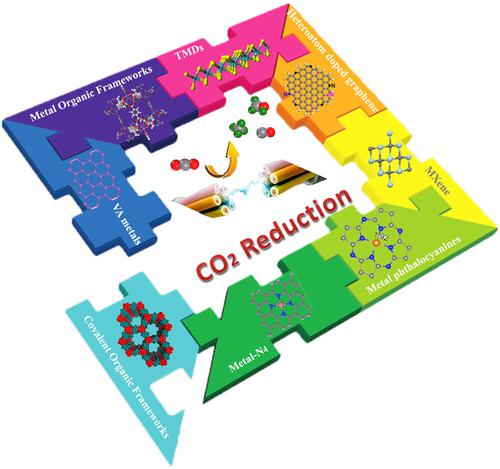当前位置:
X-MOL 学术
›
WIREs Comput. Mol. Sci.
›
论文详情
Our official English website, www.x-mol.net, welcomes your feedback! (Note: you will need to create a separate account there.)
Review of two‐dimensional materials for electrochemical CO2 reduction from a theoretical perspective
Wiley Interdisciplinary Reviews: Computational Molecular Science ( IF 11.4 ) Pub Date : 2019-04-24 , DOI: 10.1002/wcms.1416 Xiaorong Zhu 1 , Yafei Li 1
Wiley Interdisciplinary Reviews: Computational Molecular Science ( IF 11.4 ) Pub Date : 2019-04-24 , DOI: 10.1002/wcms.1416 Xiaorong Zhu 1 , Yafei Li 1
Affiliation

|
The massive use of fossil fuels emits a large amount of carbon dioxide gas, which brings inevitable damage to the ecological environment. The conversion of carbon dioxide (CO2) into organic fuel molecules or other industrial raw materials by electrochemical reduction is an important means to reduce the CO2 content in the atmosphere and establish a new carbon resource balance system. However, the currently used catalysts for electrochemical CO2 reduction are still unsatisfactory because of several serious problems, such as high overpotential, low selectivity, and high cost. Compared to conventional three‐dimensional (3D) catalysts, it is expected that two‐dimensional (2D) catalysts with ultra‐large surface area, abundant surface atoms, and excellent electrical conductivity along 2D channels could be more beneficial toward CO2 electrochemical reduction. Recently, the application of 2D materials in the field of CO2 electrocatalytic conversion has just begun to receive attention. In this overview, we summarized the latest advances on developing novel 2D materials as catalysts for CO2 electrochemical reduction and highlighted the important role of theoretical simulation in this emerging field. We hope that this overview could provide some guidance for both theoretical and experimental communities to further designing 2D electrocatalysts for CO2 reduction and understanding the corresponding mechanisms.
中文翻译:

从理论角度回顾二维电化学还原CO 2的材料
化石燃料的大量使用会排放大量的二氧化碳气体,这必然会对生态环境造成破坏。通过电化学还原将二氧化碳(CO 2)转化为有机燃料分子或其他工业原料是减少大气中CO 2含量并建立新的碳资源平衡体系的重要手段。但是,目前使用的电化学CO 2催化剂由于一些严重的问题,例如高电势,低选择性和高成本,还原仍不能令人满意。与常规的三维(3D)催化剂相比,可以预期具有超大表面积,丰富的表面原子以及沿2D通道的优异电导率的二维(2D)催化剂将对CO 2电化学还原更有利。近来,二维材料在CO 2电催化转化领域中的应用才刚刚开始受到关注。在此概述中,我们总结了开发新型2D材料作为CO 2催化剂的最新进展。电化学还原,并突出了理论模拟在这一新兴领域中的重要作用。我们希望此概述可以为理论界和实验界提供一些指导,以进一步设计用于CO 2还原的二维电催化剂并了解相应的机理。
更新日期:2019-05-16
中文翻译:

从理论角度回顾二维电化学还原CO 2的材料
化石燃料的大量使用会排放大量的二氧化碳气体,这必然会对生态环境造成破坏。通过电化学还原将二氧化碳(CO 2)转化为有机燃料分子或其他工业原料是减少大气中CO 2含量并建立新的碳资源平衡体系的重要手段。但是,目前使用的电化学CO 2催化剂由于一些严重的问题,例如高电势,低选择性和高成本,还原仍不能令人满意。与常规的三维(3D)催化剂相比,可以预期具有超大表面积,丰富的表面原子以及沿2D通道的优异电导率的二维(2D)催化剂将对CO 2电化学还原更有利。近来,二维材料在CO 2电催化转化领域中的应用才刚刚开始受到关注。在此概述中,我们总结了开发新型2D材料作为CO 2催化剂的最新进展。电化学还原,并突出了理论模拟在这一新兴领域中的重要作用。我们希望此概述可以为理论界和实验界提供一些指导,以进一步设计用于CO 2还原的二维电催化剂并了解相应的机理。


























 京公网安备 11010802027423号
京公网安备 11010802027423号